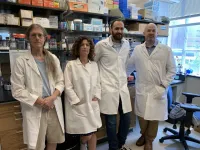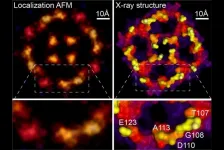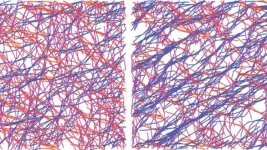(Press-News.org) Osteoporosis researchers at the UVA School of Medicine have taken a new approach to understanding how our genes determine the strength of our bones, allowing them to identify several genes not previously known to influence bone density and, ultimately, our risk of fracture.
The work offers important insights into osteoporosis, a condition that affects 10 million Americans, and it provides scientists potential new targets in their battle against the brittle-bone disease.
Importantly, the approach uses a newly created population of laboratory mice that allows researchers to identify relevant genes and overcome limitations of human studies. Identifying such genes has been very difficult but is key to using genetic discoveries to improve bone health.
"Genome-wide association studies have revolutionized the identification of regions of the human genome that influence bone mineral density. However, there are challenges to using this information to help patients, such as identifying the specific genes involved. Additionally, such studies have focused only on bone mineral density, although many other aspects of bone contribute to bone strength and risk of fracture but cannot be measured in humans," said Charles Farber, PhD, of UVA's Center for Public Health Genomics and Department of Public Health Sciences. "The ability to use mice in a novel way has allowed us to begin to overcome the challenges associated with human genome-wide association studies."
UNDERSTANDING OSTEOPOROSIS AND BONE STRENGTH
Genome-wide association studies have identified more than 1,000 locations on our chromosomes where genes are found that influence bone mineral density (BMD), a strong predictor of how likely an individual is to experience a bone fracture. But bone mineral density is only one factor in bone strength. Farber and his colleagues wanted to get a more complete picture.
They created a resource by collecting information on 55 different skeletal characteristics in hundreds of mice and then used an approach called systems genetics to analyze the data. The analysis identified a total of 66 genes that contribute to BMD, including 19 not previously linked to BMD.
Of the 19, the researchers were able to determine that two, SERTAD4 and GLT8D2, likely affect bone mineral density through cells that form bone called osteoblasts. This ability to determine the cell types that genes use to perform biological processes is one of the great strengths of systems genetics analysis, the researchers say.
The scientists also found that another gene, QSOX1, plays an important role in determining the mass and strength of the outer, "cortical" layer of bone. This type of bone makes up 80% of our skeleton and is vital for bone strength and weight bearing.
In addition to providing new insights into osteoporosis, the new findings highlight the tremendous potential of using mice to identify important genes in humans, Farber says.
"The information we generated from mice can be used in the future to evaluate these newly identified genes as potential drug targets," said Basel Al-Barghouthi, of UVA's Center for Public Health Genomics, who led the analysis. "Furthermore, these approaches can be applied across a wide range of diseases."
INFORMATION:
FINDINGS PUBLISHED
The researchers have published their findings in the scientific journal Nature Communications. The research team consisted of Al-Barghouthi, Larry D. Mesner, Gina M. Calabrese, Daniel Brooks, Steven M. Tommasini, Mary L. Bouxsein, Mark C. Horowitz, Clifford J. Rosen, Kevin Nguyen, Samuel Haddox, Emily A. Farber, Suna Onengut-Gumuscu, Daniel Pomp and Farber.
The work was supported by the National Institutes of Health's National Institute of Arthritis and Musculoskeletal and Skin Diseases, awards AR057759 and AR077992; NIH Biomedical Data Sciences Training Grant 5T32LM012416; and UVA Cancer Center Support Grant P30CA044579 from the National Cancer Institute.
To keep up with the latest medical research news from UVA, subscribe to the Making of Medicine blog (http://makingofmedicine.virginia.edu).
Woods Hole, MA (June 16, 2021) -- Woods Hole Oceanographic Institution (WHOI) climate modeler Dr. Alan Condron and United States Geological Survey (USGS) research geologist Dr. Jenna Hill have found evidence that massive icebergs from roughly 31,000 years ago drifted more than 5000km (> 3,000 miles) along the eastern United States coast from Northeast Canada all the way to southern Florida. These findings were published today in Nature Communications.
Using high resolution seafloor mapping, radiocarbon dating and a new iceberg model, the team analyzed about 700 iceberg scours ("plow marks" on the seafloor left behind by the bottom parts of icebergs dragging through marine sediment ) from Cape Hatteras, North Carolina to the Florida Keys. ...
Researchers from the Max-Planck Institute for Terrestrial Microbiology have discovered a surprising asymmetry in the mating behavior of unicellular yeast that emerges solely from molecular differences in pheromone signaling. Their results, published in the current issue of "Science Advances", might shed new light on the evolutionary origins of sexual dimorphism in higher eukaryotes.
Resemblant of higher organisms, yeast gametes communicate during the mating process by secreting and sensing sexual pheromones. However, in contrast to higher eukaryotes, budding yeast is isogamous: seen through a microscope, gametes of both mating types ("sexes"), MATa and MATα, look exactly the same. Since anisogamy -- difference in size between male and female gametes --was ...
HOUSTON ? The University of Texas MD Anderson Cancer Center's Research Highlights provides a glimpse into recently published studies in basic, translational and clinical cancer research from MD Anderson experts. Current advances include a new combination therapy for acute myeloid leukemia (AML), a greater understanding of persistent conditions after AML remission, the discovery of a universal biomarker for exosomes, the identification of a tumor suppressor gene in hepatocellular carcinoma (HCC) and characterization of a new target to treat Clostridioides difficile (C. difficile) infections.
Utilizing combination therapy for AML
While a majority of patients with acute myeloid leukemia (AML) respond favorably ...
Scientists at Weill Cornell Medicine have developed a computational technique that greatly increases the resolution of atomic force microscopy, a specialized type of microscope that "feels" the atoms at a surface. The method reveals atomic-level details on proteins and other biological structures under normal physiological conditions, opening a new window on cell biology, virology and other microscopic processes.
In a study, published June 16 in Nature, the investigators describe the new technique, which is based on a strategy used to improve resolution in light microscopy.
To study proteins and other biomolecules at high resolution, investigators have long relied on two techniques: X-ray crystallography ...
A new rubber band stretches, but then snaps back into its original shape and size. Stretched again, it does the same. But what if the rubber band was made of a material that remembered how it had been stretched? Just as our bones strengthen in response to impact, medical implants or prosthetics composed of such a material could adjust to environmental pressures such as those encountered in strenuous exercise.
A research team at the University of Chicago is now exploring the properties of a material found in cells which allows cells to remember and respond to environmental pressure. In a paper published on May 14, 2021 in Soft Matter, they teased ...
PHILADELPHIA - Amyotrophic lateral sclerosis (ALS), also known as Lou Gehrig's disease, is a neurodegenerative disease that strikes nearly 5,000 people in the U.S. every year. About 10% of ALS cases are inherited or familial, often caused by an error in the C9orf72 gene. Compared to sporadic or non-familial ALS, C90rf72 patients are considered to have a more aggressive disease course. Evidence points to the immune system in disease progression in C90rf72 patients, but we know little of what players are involved. New research from the Jefferson Weinberg ALS Center identified an increased ...
While crop yield has achieved a substantial boost from nanotechnology in recent years, alarms over the health risks posed by nanoparticles within fresh produce and grains have also increased. In particular, nanoparticles entering the soil through irrigation, fertilizers and other sources have raised concerns about whether plants absorb these minute particles enough to cause toxicity.
In a new study published online in the journal END ...
Although each organism has a unique genome, a single gene sequence, each individual has many epigenomes. An epigenome consists of chemical compounds and proteins that can bind to DNA and regulate gene action, either by activating or deactivating them or producing organ- or tissue-specific proteins. As it is a highly dynamic material, it can provide a large amount of information to shed light on the evolution of the various tissues and organs that make up the body.
Now, a team from the Institute of Evolutionary Biology (IBE), a joint centre of the Spanish National Research Council (CSIC) and Pompeu Fabra University, has carried out the largest study to date on the regulatory ...
By repurposing common ingredients in hair conditioner, scientists have designed an inexpensive, transparent coating that can turn surfaces like windows and ceilings into glue pads to trap airborne aerosol droplets. This new strategy is described June 16 in the journal Chem.
"Facing a pandemic, we need to proactively leverage all of the different layers of defense mechanisms, including the physical barriers," says corresponding author Jiaxing Huang, a professor of materials science and engineering at Northwestern University. "After all, these viruses must travel through physical space before reaching and eventually infecting people."
The ...
Small modeling errors may accumulate faster than previously expected when physicists combine multiple gravitational wave events (such as colliding black holes) to test Albert Einstein's theory of general relativity, suggest researchers at the University of Birmingham in the United Kingdom. The findings, published June 16 in the journal iScience, suggest that catalogs with as few as 10 to 30 events with a signal-to-background noise ratio of 20 (which is typical for events used in this type of test) could provide misleading deviations from general relativity, erroneously pointing to new physics where none exists. Because this is close to the size of current catalogs used to assess Einstein's ...




